All about dishwasher fronts
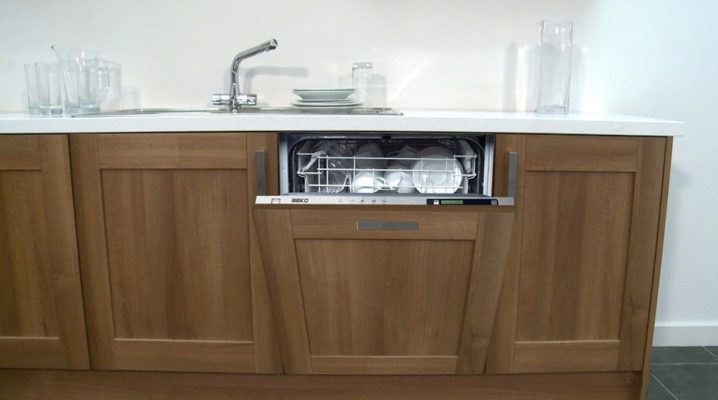
With the purchase of a dishwasher, the number of household chores in the house is significantly reduced. I always want to make sure that such a convenient thing as a dishwasher fits into the interior of the kitchen and does not stand out. The solution to this problem is the facade. This decorative panel can also serve other purposes. The article will discuss what facades are, how to choose and install them, as well as how to dismantle them.
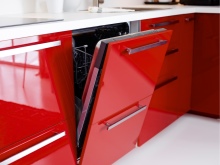
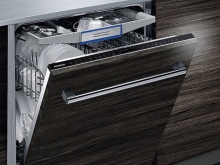
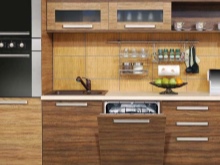
Species overview
As has already become obvious, the front of the dishwasher is a decorative panel that is installed on the front of the device, usually on the door. Facades can be conditionally divided according to several criteria.
-
Dimensions (edit)... Facades must be selected according to the dimensions of the device itself. Standard machine dimensions can be 450-600 mm in width and 800-850 mm in length. And there are also unique models with excellent dimensions. Ideally, the facade should be slightly larger than the outside of the car, but this is not always possible. The bottom edge of the facade should be at the same level as the rest of the kitchen, and the top edge should end 2 to 3 cm from the countertop.
-
Manufacturing material... Often the panels are made of MDF and laminated chipboard. Chipboard models are cheap, but not entirely safe - they can emit harmful fumes when heated. And also the raw material can be plastic and solid wood. A rare case is the use of combined materials. For example, glass and wood or wood and metal. Models made only of wood are the most expensive and rare. The reason is quite trivial - in order for the wooden facade not to deform under the influence of temperature, a high-quality surface treatment is required. Finishing not only wood, but also other panels can include enamel coating, various metals, glass, plastic, wood.
-
Installation method. At the moment, there are three main methods of panel installation - conventional, sliding and sliding. When using the first method, the panel is installed in the classic way - the facade is attached directly to the dishwasher door. In the second method, the facade, when the door is opened, moves upwards parallel to the door. In this case, the facade is also attached to the door. The sliding front is only partially installed on the device door. When the dishwasher is opened, the protective panel will also move up and be parallel to the surface of the door. The last two options are used if you do not want to greatly deform the surface of the device.
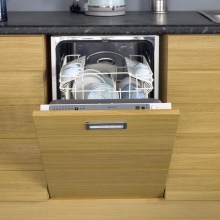
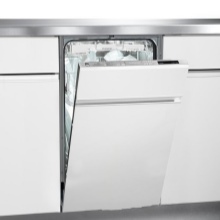
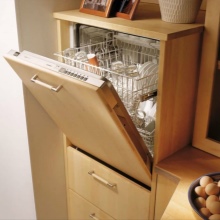
How to choose?
Professionals give some tips on how to choose the right decorative panel for your dishwasher.
-
As already mentioned, the most important thing when choosing is dimensions of the dishwasher. You will not need to select the facade yourself if you purchase or order it complete with a dishwasher. The seller will already know the dimensions of the future panel.
-
As a facade you can use the door of an old cabinet. In this case, it will be important to compare the old holes with those that will need to be made to install the panel. If they match, then it is better to abandon such a facade, as this will lead to the fact that it will be poorly attached. If everything is in order, then you can proceed with the installation.
-
If you are making a custom-made panel, then you can use the diagram provided by the device manufacturer. All dimensions will be indicated there. The standard width is 45-60 cm, the height can reach up to 82 cm. However, the dimensions may not always be indicated correctly (the manufacturer often rounds them). It is necessary to measure the dimensions of the device door yourself. The thickness of the facade should not be more than 2 cm. This value is considered the most convenient and sufficient for the panel to perform its functions.
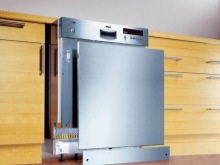


For those who think over the interior of the kitchen from scratch, professionals advise first to choose the technique, and only after that think about the interior. As a rule, the dimensions of all household appliances are fixed, while the kitchen can be of any design and size. This should be done so that after that you do not have to cut the countertop or move the cabinets so that the dishwasher becomes part of the interior.
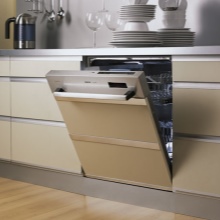
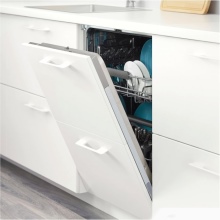
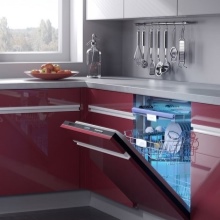
Mounting methods
It is no secret that fixing the panel is very important, it needs to be given special attention.
There are two ways to fix the facade.
-
Partial fastening... In this case, the panel covers the main part of the door, while the control panel remains visible.
-
Complete installation. The dishwasher door is completely closed by a panel.

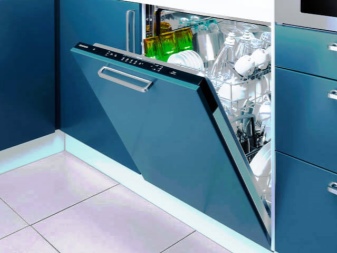
The most common fastening is with self-tapping screws. They are screwed in from the inside. It is necessary to choose the correct length of self-tapping screws. Thus, it will be possible to avoid seeing the screw heads on the outside of the panel. Another common fastening is hinges. They can be purchased complete with a facade. They are attached to the bottom edge of the dishwasher.


It is categorically impossible to attach the facade to any kind of glue. During operation, the dishwasher door can either heat up or cool down, depending on the dishwashing mode. Due to such differences, the glue can lose its properties and, as a result, the panel will fall off. And such an option is also possible - the glue will firmly glue the panel to the device door, which is also inconvenient. If dismantling is necessary, it will be impossible to peel off the panel. Another mistake is to glue the panel with tape. This is not enough to hold the panel. During the operation of the machine, the facade can simply fall off.
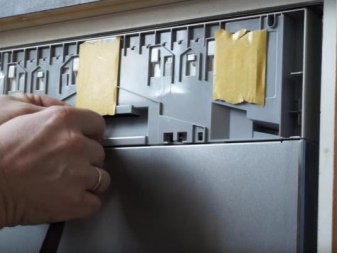
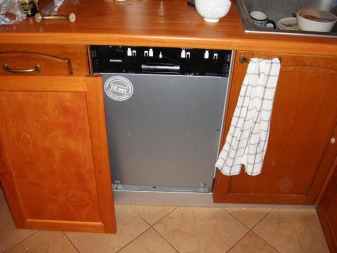
How to install it yourself?
The first step is to prepare the tools. You may need screwdrivers, a tape measure, a screwdriver (a device that resembles a drill, but designed to screw in and out self-tapping screws), a pencil for marking and an awl for making holes. And you will also need a few more tools, which will be discussed during the description of the installation process. It is not recommended to turn on the machine before you finish fixing the facade. The panel is a heat insulating and sound insulating layer. However, here we consider the hinge more as a decorative element, therefore, we analyze in detail the process of how to install it on a built-in dishwasher, and not on an ordinary one.

Installation at the desired height
- First you need to install the dishwasher itself. It is installed on 3-4 support legs, two hoses are supplied to it (drain and supply water). A table top must be installed on top of the machine. It is necessary to check whether the dishwasher is level with the side cabinets or the worktop itself. Do not install a protective panel on a crooked dishwasher. The facade in this case will also be curved. At the final stage, it is not recommended to immediately tighten the screws. First you need to screw them loosely, and if the facade is installed correctly, then after that you need to tighten the screws.

- The second step is to determine the dimensions of the panel.... It seems that the width of the panel should match the width of the device. This is not entirely true - the panel should be 2 cm shorter than the dishwasher door.The length can be different, the main requirement is only one - the panel should not interfere with the closing and opening of the device door.
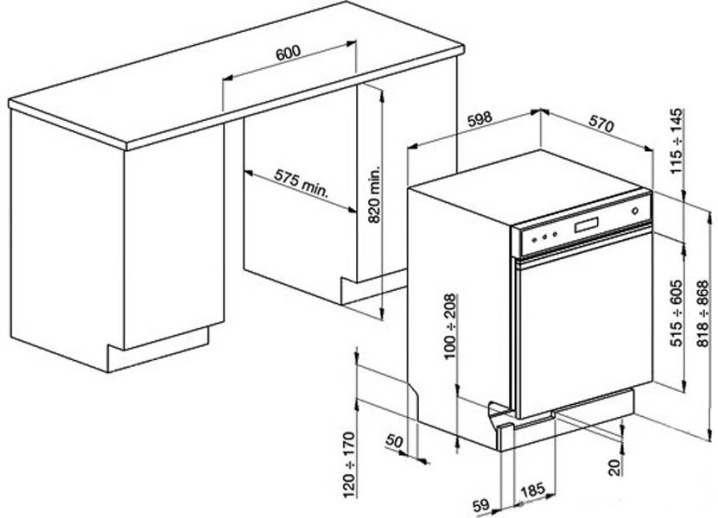
- Choose a fixing method. Usually, the manufacturer immediately indicates the appropriate fixing method. The easiest and most reliable way is to use self-tapping screws. It is undesirable to use nails - they deform the car door, and it will be difficult to remove them if necessary. Self-tapping screws are relatively easy to screw and unscrew. Often on the facade there are already pre-made holes for self-tapping screws. But if they are not there, then you can drill them yourself. For this, a pre-prepared paper stencil is taken and applied to the inside of the facade. Already according to this scheme, holes are made.


- All screws that are attached to the dishwasher door must be removed... For this, a screwdriver is used. This must be done because such fasteners are not suitable for installing the facade.

Before you hang the facade on the screws, you must first check the dimensions and location of the future panel. Adjusting the door in this way is easy and simple - using double-sided tape. In this position, be sure to close and open the door. It is also important to check and make sure that the gap between adjacent cabinets is ideal (2 mm). Next, the screws are fastened, which will be discussed below.

Installation of fasteners and fittings
The panel is laid on a flat surface (usually on the floor), and holes for self-tapping screws are drilled in it using a stencil. It is best to attach the diagram with double-sided tape. If it is difficult to drill the holes right away, then you can first pierce the locations of the holes with an awl through the paper with an awl, and then, removing the stencil, drill them with a drill.
Next, you need to install the mounting brackets. To do this, you need to cut out the rubber gaskets and screw them together with the brackets to the bottom of the lining. The final step is screwing long screws through the holes in the dishwasher door. The holes must line up with the holes in the panel. As a rule, four self-tapping screws are enough for fastening.


The handle must be installed at the same height as other handles on adjacent cabinets... When installing the handle, holes are drilled from the front side of the panel, but self-tapping screws are screwed in from the back. This is done so that cracks do not form on the front surface. After completing all work, you must open and close the door. It is important to pay attention to the distance from the edges of the panel. If the panel interferes with this, then it is necessary to carefully trim the edges of the facade. Often, facades are now sold together with an assembly kit, which includes all fasteners and fittings, which is very convenient.
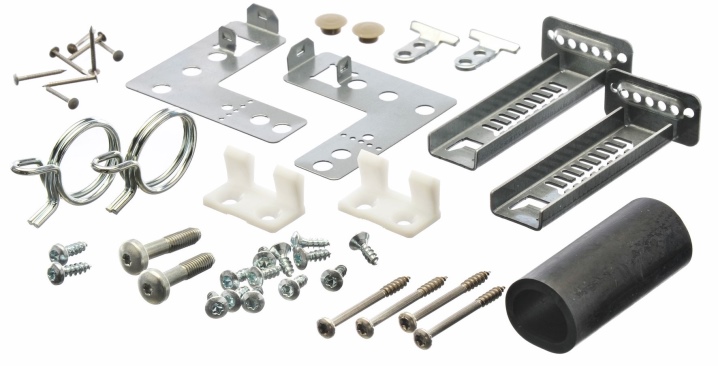
How to remove?
Obviously, dismantling the facade is easier than installing it. The main tool you will need is a screwdriver and a few attachments. The process itself consists of a few simple steps.
-
The door needs to be opened. In order for it not to close, it is weighted down (usually an iron or large books).
-
Next, you need to alternately unscrew all the screws, located on the inside of the door.
-
Grasp the panel by the edges and carefully remove it, then put it on the floor.
The facade can be removed both horizontally and vertically. Do not remove the facade by directing it towards the floor. It is necessary to direct it towards you during removal.
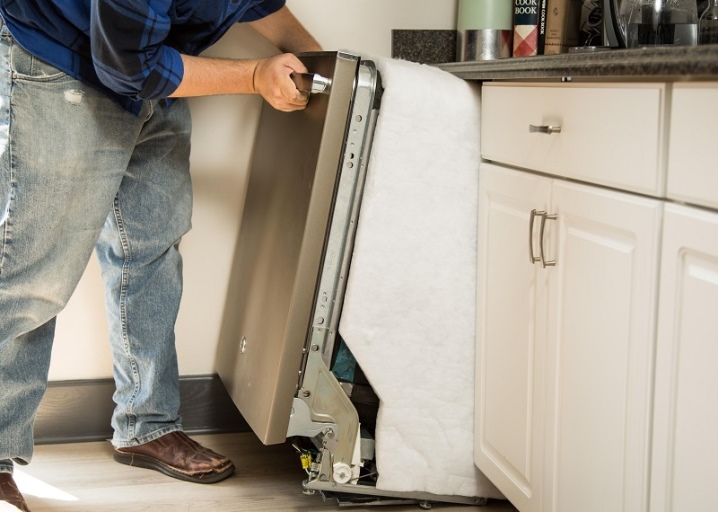













The comment was sent successfully.